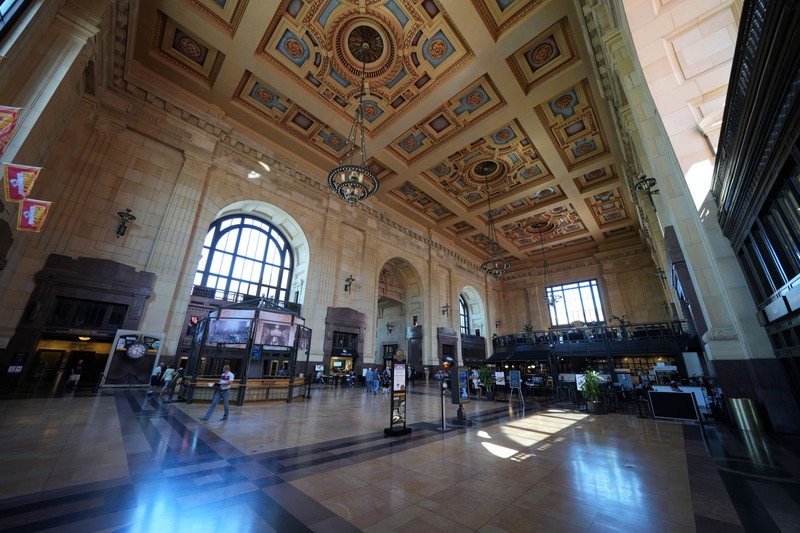Grand Hall and Harvey's Restaurant
Introduction
Text-to-speech Audio
Visitors to Kansas City following its opening in 1914 considered Union Station's Grand Hall to be the city's front porch. For nearly anyone in that era, Union Station was the first impression and final memory for those traveling to or from the city. Following a $250 million restoration funded by a sales tax levy and private investment, the station reopened in 1999 with a variety of restaurants and attractions. The central feature of Grand Hall is Harvery's Restaurant, a nod to the influence of Kansas City-area railroad restaurant innovator Fred Harvey.
Images







Backstory and Context
Text-to-speech Audio
Union Station’s Grand Hall is a resplendent, majestic setting which simultaneously makes someone in the space feel incredibly small and regal at the same time. The hall is over 200 feet long and 96 tall. The walls are a mustard-colored Kasota limestone and the geometric patterns in the marble floor mirror those of the plasterwork soaring overhead.
The steel foundations and framing structures were built with hot iron rivets, and a four-story “falsework” was assembled inside the hall to aid in the construction of the roofing and ceiling plasterworks. Each of these tasks involved many workers. Wet plaster was applied by one man and then formed with a mold by another before it cold dry. Following behind that was the meticulous detail work and painting. Similarly it took workers over an hour to raise and place the huge chunks of Bedford limestone, the favored material for official government structures like the capitol.
Author Jeffery Spivak describes the scene in his book, “Union Station Kansas City:”
“Travelers and curiosity seekers seeing the station for the first time would pass - starting on the west side of the Grand Hall and proceeding clockwise - the baggage-check area near the west door, a parcel checkroom, the men’s smoking room with benches and white marble wainscotting, then a barber shop with 12 chairs and a fruit and candy store. Heading farther east, the visitor reached a coffered arch in the middle of the room - the middle of three arches on the north wall aligned with the arch windows in the South wall. Attached to that wall was a semicircular ticket office with bronze grill work. Hanging from the top of the arched entrance to the waiting room was a 6-foot-wide clock. The waiting room beyond was more than 300 feet long and its own, smaller arched windows admitting rays of sunlight on pewlike mahogany benches aligned in parallel rows. Farther eastward in the Grand Hall, the visitor passed the women's waiting room - guarded by a matron - a drugstore and, finally, through bronze doors into the east wing, the Fred Harvey restaurant. It featured a long, U-shaped lunch counter in one room and an elegant dining room next door.”
Now, in the center of the Grand Hall, the U-shaped Fred Harvey restaurant sits where once the ticketing booths were. Originally, the restaurant was on the east side of the hall where Pierpont’s is now. Fred Harvey opened his first rail station restaurant in 1876 in Topeka, Kansas with the help of the Santa Fe railroad line. Harvey lamented the state of train dining and saw a lucrative opportunity to fill the void.
At the time of his death in 1901, the Fred Harvey Company operated 47 restaurants. At the peak, the number of Harvey House restaurants numbered in the eighties. The enterprise continued into the 1960s, with Harvey's son, and later, his grandson, at the helm. By the time Union Station opened, the restaurant empire was controlled by his son, Ford Harvey, who had an office above present-day Pierpont’s. This office contained the station’s only working fireplace.
Legend has it that Fred Harvey was disappointed by his male waitstaff and sought out “young women, 18 to 30 years of age, of good character, attractive and intelligent.” The mythic qualities of purity and service deployed by the “Harvey Girls” led to the 1946 film by the same name staring Judy Garland. The girls were asked to stay on for at least six months due to the number that were courted by cowboys and railroad travelers. More speculation has it that over 20,000 Harvey Girls ended up marrying people they met on the job and over 4,000 babies from those unions were reportedly named “Fred” or “Harvey.”
The original Harvey’s lunch counter sign can still be seen in the Amtrak waiting room.
Sources
Jeffrey Spivak, Union Station Kansas City, The Kansas City Star Books, Kansas City, Missouri, 1999.
Photo by David Trowbridge
Photo by David Trowbridge
